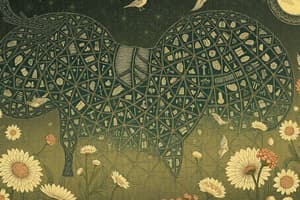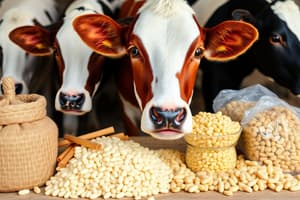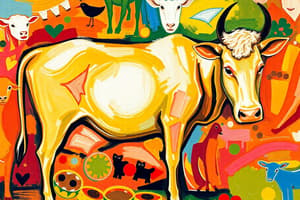Podcast
Questions and Answers
A livestock farmer is evaluating a potential feed source. The feed contains 25% crude fiber and 65% total digestible nutrients. According to the standard classification, how should this feed be categorized?
A livestock farmer is evaluating a potential feed source. The feed contains 25% crude fiber and 65% total digestible nutrients. According to the standard classification, how should this feed be categorized?
- Dry roughage (correct)
- Protein concentrate
- High-energy concentrate
- Succulent roughage
A dairy farmer wants to supplement their cows' diet with a feed that is high in both energy and protein. Which of the following combinations would best meet these requirements?
A dairy farmer wants to supplement their cows' diet with a feed that is high in both energy and protein. Which of the following combinations would best meet these requirements?
- Hay and molasses
- Cereal grains and oilseed meal (correct)
- Ensiled roughages and vitamins
- Pasture grasses and mineral supplements
A feed manufacturer is formulating a new feed for poultry. They want to include an additive that will improve the birds' gut health and nutrient absorption. Which of the following feed additives would be most suitable for this purpose?
A feed manufacturer is formulating a new feed for poultry. They want to include an additive that will improve the birds' gut health and nutrient absorption. Which of the following feed additives would be most suitable for this purpose?
- Antifungals
- Antibiotics
- Hormones
- Probiotics (correct)
A nutritionist is advising a farmer on how to preserve the vitamin content of harvested forage. Which of the following practices would be MOST effective in minimizing vitamin loss?
A nutritionist is advising a farmer on how to preserve the vitamin content of harvested forage. Which of the following practices would be MOST effective in minimizing vitamin loss?
A pig farmer notices that their animals are not growing at the expected rate, despite consuming adequate amounts of feed. After consulting with a vet, they suspect a mineral deficiency. How would you advise the farmer to proceed?
A pig farmer notices that their animals are not growing at the expected rate, despite consuming adequate amounts of feed. After consulting with a vet, they suspect a mineral deficiency. How would you advise the farmer to proceed?
Flashcards
Dry Roughages
Dry Roughages
Bulky feeds with low weight per unit volume, high in crude fiber, and low in protein and fat digestibility.
Succulent Roughages
Succulent Roughages
Feeds with high moisture content such as pasture grasses and fresh legumes.
Silages & Haylages
Silages & Haylages
Fermented, high-moisture feeds made from plant material, differing in dry matter content.
Protein Concentrates/Supplements
Protein Concentrates/Supplements
Signup and view all the flashcards
Feed Additives
Feed Additives
Signup and view all the flashcards
Study Notes
- There are eight classes of feedstuff
Eight Classes of Feedstuff
- Dry roughages
- Succulent roughages include pasture and range grasses
- Ensiled roughages
- High energy concentrates
- Protein concentrates
- Minerals
- Vitamins
- Additives
Dry Roughages
- Bulky feed with low weight per unit volume
- High crude fiber content, low protein and fat digestibility
- Classified as a roughage if it contains greater than 18% crude fiber and 70% total digestible nutrients
Dry Roughage Examples
- Hay
- Straw and Chaff
- Sugarcane bagasse
- Corn cobs
- Cottonseed hulls
Succulent Roughages
- Pasture grasses, both natural and cultivated
- Fresh legumes
- Tree leaves
- Roots and tubers
Silages & Haylages
- Fermented high moisture feed made from plant material
- Silage has 20 – 45% dry matter (DM)
- Haylage has 50 -75% DM
High Energy Concentrates
- Cereal grains and milling by-products of cereal grains are common
- Molasses are included
- Animal and vegetable fat
Protein Concentrates/Supplements
- Protein concentrates contain greater than 20% Crude Protein (CP)
- Oil seeds and their meals like SBM and Copra meal are good protein sources
- Animal, avian, and marine sources such as Fish meal and meat meal
- Milk and milk by-products
- Brewery and distillery by-products
- Urea and ammonia
Vitamins & Mineral Supplements
- Vitamins and minerals must be added by sources that are able to be absorbed by the animal
- Vitamin concentration varies greatly in both plant and animal tissues
- Vitamin concentrations in plants are affected by harvesting, processing, and storing
- Liver and kidney are good sources of vitamins in animals
Feed Additives
- These are non-nutritive ingredients added to stimulate growth, performance, or to improve a feed’s efficiency
- Additives are added in very small quantities
- Classes of additives:
- Antibiotics, antifungals, and antimicrobials
- Probiotics, buffers
- Colors, flavors
- Hormones, Enzymes
Studying That Suits You
Use AI to generate personalized quizzes and flashcards to suit your learning preferences.




